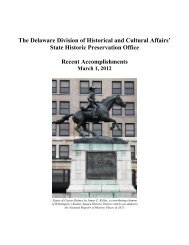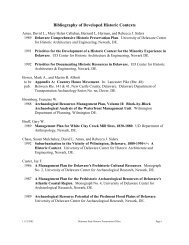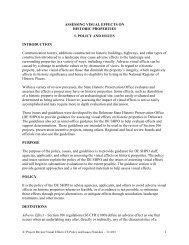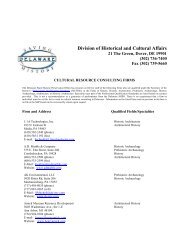Report of the Archaeological Investigations of the New Castle Court ...
Report of the Archaeological Investigations of the New Castle Court ...
Report of the Archaeological Investigations of the New Castle Court ...
Create successful ePaper yourself
Turn your PDF publications into a flip-book with our unique Google optimized e-Paper software.
NEW CASTLE COURT HOUSE PLAZA<br />
NEW CASTLE, DELAWARE<br />
4.0 ARTIFACT ANALYSIS<br />
The assemblage is generally divided between imported fill matrices (within SUs B, F, and I) and<br />
intact contexts native to <strong>the</strong> <strong>Court</strong> House property (SUs C, E, and J; Features 20, 22, 37, and 60).<br />
The former group consists <strong>of</strong> 52 artifacts recovered from <strong>the</strong> sand deposits. This material was<br />
likely excavated from a nearby (but now unknown) coastal site at <strong>the</strong> time <strong>of</strong> <strong>the</strong> brick plaza<br />
construction. The sand fill deposit assemblage was found to contain mostly lithic chipping debris<br />
(n=47; 90%) including 25 chert, 19 jasper, 2 quartz, and 1 quartzite flakes/shatter. The five<br />
remaining items consisted <strong>of</strong> two untyped projectile points (a jasper notched point and a chert<br />
bifurcate), a possible quartzite chopper/cobble tool, and 2 pieces <strong>of</strong> quartzite fire-cracked rock.<br />
The prehistoric assemblage recovered from secondary deposits within <strong>the</strong> plaza stratigraphy or<br />
from intact historic-era features identified at <strong>the</strong> base <strong>of</strong> <strong>the</strong> plaza fill contained a slightly<br />
different artifact class than seen previously. Like <strong>the</strong> artifacts recovered from <strong>the</strong> sand fill<br />
deposits, <strong>the</strong> bulk <strong>of</strong> this assemblage (n=54) was found to be largely composed (78%) <strong>of</strong> <strong>the</strong><br />
byproducts associated with stone tool production and/or maintenance activities. The artifacts<br />
included were 40 flakes/shatter (21 jasper, 15 chert, 3 quartz, and 1 quartzite) and 2 core<br />
fragments (jasper, chert). The remaining items consisted <strong>of</strong> 11 unidentified prehistoric ceramics<br />
and a non diagnostic jasper scraper/plane (Plate 24).<br />
4.4.6 STRAIGHT PINS<br />
“There is scarcely any commodity cheaper than pins, and but few that pass through more hands<br />
before <strong>the</strong>y come to be sold” (Hurley n.d.:40). Not surprisingly, straight pins are a fairly common<br />
occurrence within a wide variety <strong>of</strong> historical archeological sites ranging from domestic to<br />
commercial to governmental. A number <strong>of</strong> straight pins and pin fragments (n=195) were<br />
recovered from <strong>the</strong> plaza deposits. The overwhelming majority <strong>of</strong> pins were brass and typically<br />
measured between 0.5 to 1.25 in. in length. The pin heads all appear to be constructed from a<br />
second piece <strong>of</strong> wire coiled around <strong>the</strong> end, and some still exhibit <strong>the</strong>ir original tin plating. The<br />
coiled pin head construction technique was commonly used from <strong>the</strong> early seventeenth through<br />
<strong>the</strong> early-nineteenth century, at which time a single stamped pin was developed (Nöel Hume<br />
1969:254; Longman and Loch 1911:21). The smaller examples within <strong>the</strong> <strong>New</strong> <strong>Castle</strong><br />
assemblage (those measuring approximately 0.5 in.) are called Lilliputian pins or “Lils,” and are<br />
most commonly attributed to use by women to pin <strong>the</strong>ir clo<strong>the</strong>s in place (Mary Beaudry, personal<br />
communication, September 2004; Longman and Loch 1911:24). The remaining pins represent a<br />
more general purpose straight pin, those known as “Short Whites,” with an average length <strong>of</strong><br />
slightly more than one in. (Mary Beaudry, personal communication, September 2004). A number<br />
<strong>of</strong> <strong>the</strong> straight pins were found bent in half (contexts 158 and 161) and one bent pin was attached<br />
to a black glass bead (context 158).<br />
The recovery <strong>of</strong> large numbers <strong>of</strong> straight pins from a non-domestic and non-commercial site<br />
raises requires some explanation. Stanley South’s investigations at <strong>the</strong> Public House – Tailor<br />
Shop in South Carolina recovered a large number <strong>of</strong> pins, but this was from a very different<br />
context than that <strong>of</strong> a <strong>Court</strong> House (South 1977:65-71). When pins were sold <strong>the</strong>y were purchased<br />
stuck in paper and occasional documents housed in archives still bear <strong>the</strong> pins that held <strong>the</strong>m<br />
toge<strong>the</strong>r (Hurley n.d.:40). Aside from <strong>the</strong> “Lils” and bent pins, which may have been used for<br />
personal adornment, <strong>the</strong> prevalence <strong>of</strong> straight pins at <strong>the</strong> <strong>Court</strong> House may be related to<br />
fastening or clipping paper documents toge<strong>the</strong>r. This idea is fur<strong>the</strong>r supported by archeological<br />
investigations from government or public facilities, such as <strong>the</strong> recent work conducted at <strong>the</strong> State<br />
House in Dover, Delaware, at Old Fort Western in Maine, and at <strong>the</strong> Deshler-Morris House in<br />
Germantown (Crozier 1978). Recent analysis <strong>of</strong> <strong>the</strong> Delaware State House artifact assemblage in<br />
Dover has revealed <strong>the</strong> presence <strong>of</strong> a minimum <strong>of</strong> 218 straight pins at that site (Charles Fithian,<br />
73









